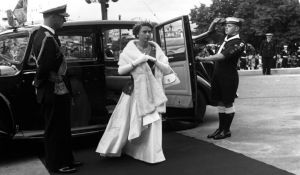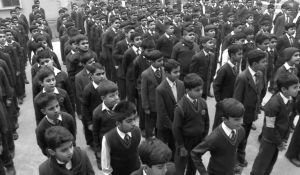The announcement that Members of the Parliament of the United Kingdom of Great Britain and Northern Ireland, otherwise known as the UK Parliament or the British Parliament, voted to introduce a bill as to whether or not England should have its own official national anthem instead of God Save the Queen caused me to muse over when Australia’s national anthem was God Save the Queen.
Six months after Queen Elizabeth II was crowned monarch of the UK she became the first reigning monarch to set foot on Australian soil. She visited all the Australian states and the capital cities, except Darwin. Wherever she visited there were chants of We want the Queen; We want the Queen; and She was met with a sea of waving flags. Australia’s national anthem, God Save the Queen, filled the air. All Australians were swept up by the thrill of her visit; the McAdam’s were no exception. One evening we joined the excited crowd lining Victoria Street in the hope of catching a fleeting glimpse of Her as she was leaving Melbourne’s Lord Mayor’s Royal Ball at the Exhibition Building. We waved madly as the royal car hurried by.

image:thetimes
In the sixties, every Victorian School had a Monday morning assembly. At Williamstown Technical School our assemblies were held in what was the asphalt quadrangle used for bat tennis games; at least six courts were painted on the asphalt. The teacher’s car park insulated the quadrangle from busy Kororoit Creek Road. It was bordered on one side by the wing of the school that housed the teacher’s staff room and the principal’s office. The flag pole stood alone on the opposite side and beyond was an open green space; the assembly hall was yet to be built. The front of the parade ground faced the wing of the building that was the Science, Art, and Mr Morrow’s Accounting rooms.

image:bbc.com
The teacher leading the assembly, Mr Mellington the senior science teacher, stood on a small raised platform in front of the outside of the science rooms. The fifth, fourth, and third forms lined up to the left, and the second and first forms to the right on the parade ground. The flag pole was to the left of the school assembly which always started with all students standing at ease lined up alphabetically in descending form order, and with caps on.
And we waited for his commands.
School AAA-TEN-SHUN. And we snapped from our legs apart, hands clasped behind the back at ease stance, to hands by the side and legs and feet together.
Caps OFF and FAAA-CE the flag. The assembly turned as one and swiftly removed their caps.
REEE-PEAT after me.
I Love God and my country
I honour the flag
I will serve the Queen
And cheerfully obey my parents, teachers and the law
School SALUUUU-TE the FLAG. And on cue the national anthem God Save the Queen was played.
CAAA-PS ON and face the front.
STAAAA-ND at ease.
If there were no school announcements or a snap uniform inspection then the call was music, please.
School MAAAAA-RCH off.
Years ago someone had worked out an intricate marching order for each form based on the location of the room of the first class that each form was timetabled for on Monday mornings. The parade ground became twisting, intertwined, writhing, lines of five hundred or more marching, disinterested, students.

image:stock-clip.com
Every Monday morning we saluted the flag and recited the Oath of Allegiance. Most of us didn’t think about the words during the week: but we recited them every Monday.
It just seems like yesterday, when God Save the Queen, was played in every picture theatre, concert hall, and every public event in Australia. As soon as the picture theatre lights dimmed God Save the Queen played and we stood in silence, at attention, in the darkened theatre. Latecomers being shown to their seats, by the light of the usher’s torch, promptly stopped and stood at attention when they heard the opening drum roll of the national anthem. We were told by Mum that it was bad manners and disrespectful to the Queen if we didn’t stand at attention when God Save the Queen was played. At first, I felt ashamed when I saw some latecomers ignore the anthem and push past the usher so they could find their seats before the newsreel started. I would steal furtive glances at the latecomers and would secretively watch them as they found their seats: this was my initial introduction to a social-political demonstration and anti-monarchy protest in a public place. Several years later I became one of the disrespectful. Playing the anthem had been migrated to the end of the main feature. When the lights went up and the theatre transitioned from dark to dim the national anthem was projected on the screen and we were expected to rise from our seats and stand at attention facing the screen.

image:indiatimes.com
The day I decided to stay seated as the six opening bars of the anthem filled the theatre was no different than any other. The screen filled with a splendid montage of Her on horseback taking the salute at the Trooping the Colour, sitting majestically on the throne wearing the royal robes and crown and then cavorting stately with the corgis. I was admonished by the man behind me standing at attention as I stayed seated: what of my allegiance and reverence to the queen. I had heard my young inner angry voice grunting out against the monarchy: I wondered how important the Queen was to Australia as it started growing into Australia.
Before Australian television stations started 24-hour broadcasting they would sign off around ten o’clock at night. Sign-off was announced by playing the national anthem, God Save the Queen. The drums rolled, and the Queen appeared on horseback surrounded by her gold-braided soldiers; this image then dissolved into a cackling kookaburra and then the Australian flag. The sign-off was always followed by the test pattern. And I refused to jump out of the chair and stand at attention in front of the television while the anthem played; to be upstanding for Her Majesty during the television sign-off. But I did wonder if God Save the Queen was played at the end of the day’s programming because of the tradition in picture theatres of playing the national anthem at the end of the main feature.

image:okolo.me
The seventies were defined by change. Many saw the 1972 Australian Whitlam Government as a catalyst of change. They introduced reforms that included establishing formal relations with China, repealing conscription laws and withdrawing all Australian forces from the Vietnam War, abolishing tertiary education fees, returning traditional lands in the Northern Territory to the Gurindji people, and adopting Advance Australia Fair as Australia’s national anthem. In 1975 the Whitlam Government was dismissed by Governor General Sir John Kerr and the subsequent Malcolm Fraser government reversed the national anthem decision. This insidious act by the Crown’s Australian representative was another stimulant that caused many to question Australia’s identity with Britain and the Queen.
And I never stood at attention again for the playing of God Save the Queen.
In 1984, seven years after a plebiscite asked Australians their preference for a national anthem, the incoming Bob Hawke government officially replaced God Save the Queen as the national anthem with Advance Australia Fair. In 1986 the Australia Act was passed by both the Australian and the United Kingdom Parliaments. The Australia Act terminated; the power of the Parliament of the United Kingdom to legislate for Australia, for the UK to be involved in the Australian government, and for an appeal from any Australian court to a British court.
The Melbourne Cricket Ground was the place of perfect peace and happiness for ninety-odd thousand raucous Australians when Olivia Newton-John sang Advance Australia Fair before the 1986 Carlton Hawthorn Grand Final.
Australians all let us rejoice
For we are young and free
We’ve golden soil and wealth for toil
Our home is girt by sea
Our land abounds in Nature’s gifts
Of beauty rich and rare
In history’s page, let every stage
Advance Australia fair
In joyful strains then let us sing
Advance Australia fair
The Sex Pistols: God Save The Queen 1/14/1978 Winterland
My dear Mr. McAdam,
What a joy to be from a country with a single national anthem. I have found that many citizens in the country where you live are confused on what our national anthem is, and should they single it prior to a summer sporting event, end up humming or mumbling some of the words.
Oh to have had some like ON-J to sing at our events.
LikeLike
John, you certainly are an astute observer of spectators at sporting events. While it is true that Australians do mumble some of the words of The Star Spangled Banner there is a reason. Most Australians think the US national anthem is Johnny Cash’s Song Of The Patriot and they start singing: I’m a flag waving patriotic nephew of my Uncle Sam, a rough riding fighting Yankee man. I love mom and apple pie and the freedoms that we all enjoy, across this beautiful land. Thank you John for your keen comment.
LikeLike
Monarchies, some of the last remaining bastions of privilege through heritage. They should all be deposed with the proceeds of their (in most cases) centuries of looting and plundering from the general population returned to the people.
LikeLike
M.E. your insightful comment caused me to wonder about other royal families. I was surprised to learn that there are 25 other families apart from the Windsors who have direct political power or who just reign. Now this does not include the monarchs of Moomba; the king and queen for 2015 was Australian cricketing royalty Shane Warne and Melbourne Bollywood star Pallavi Sharda. A new king and queen are crowned each year.
LikeLike